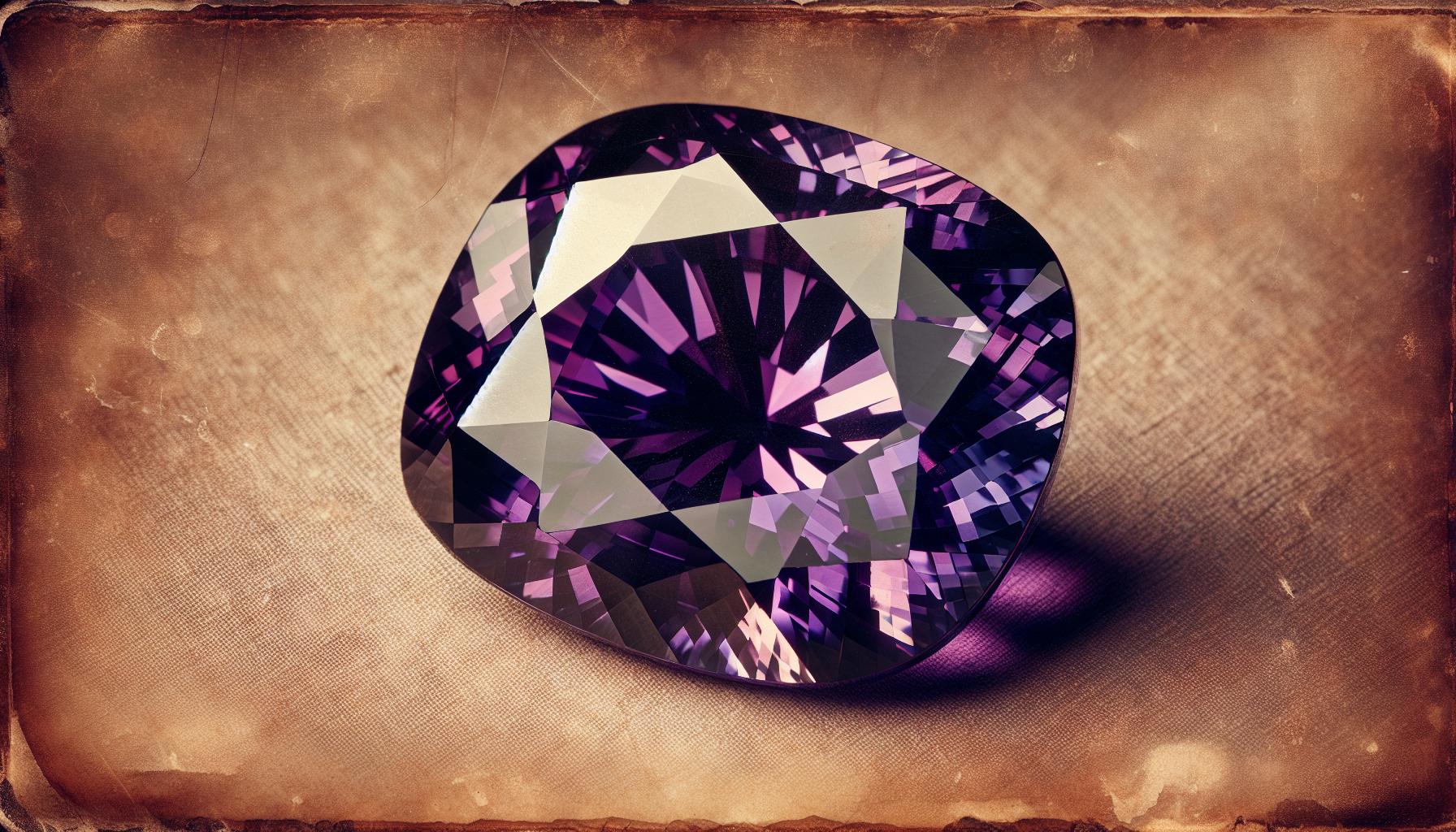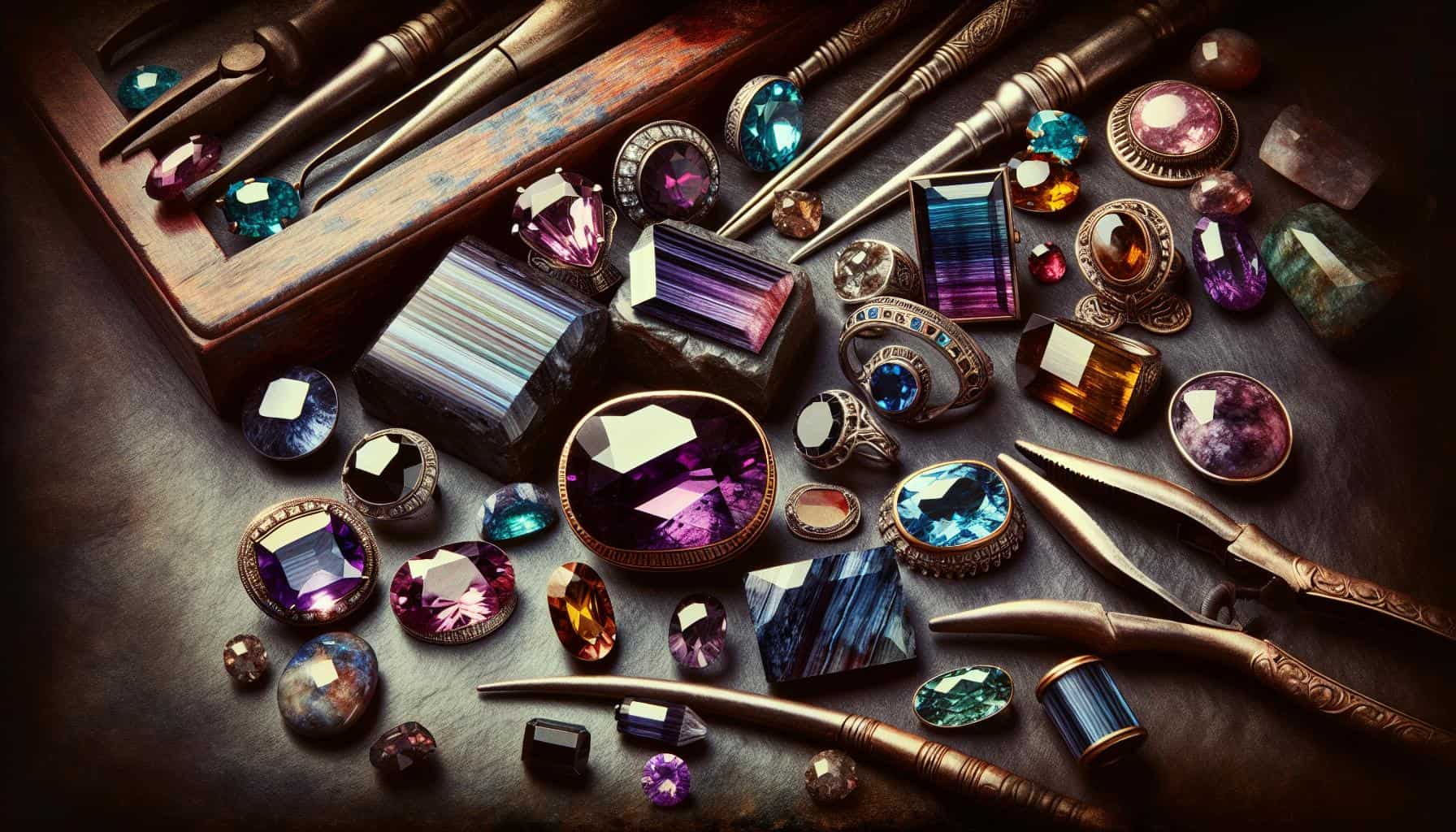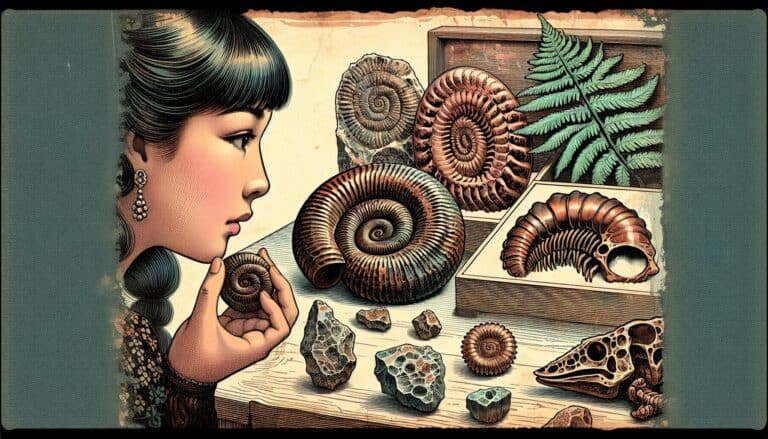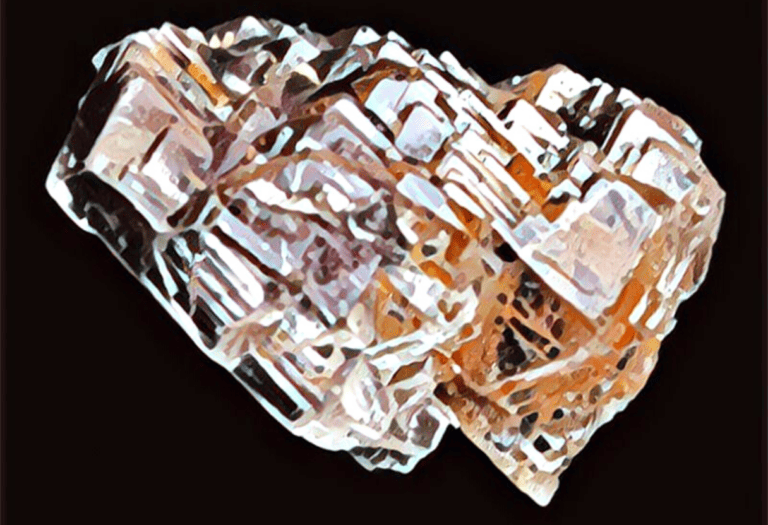Ever wondered about the value of that vibrant, purple gemstone called sugilite?
It’s a question that’s crossed the minds of many collectors and jewelry enthusiasts. Sugilite’s worth can vary widely, and understanding what drives its value is key to making informed decisions about purchasing or investing in this alluring mineral.
Factors like color, clarity, and size play a huge role in determining sugilite’s price. Rarity and origin also add to its allure, with some pieces commanding top dollar in the gemstone market.
Stick around and you’ll uncover the nuances of sugilite’s valuation and what makes it such a sought-after stone.
Sugilite’s value is influenced by its color, clarity, size, and rarity. The most valuable sugilite is deep purple with red undertones and minimal inclusions. Its rarity, particularly in larger sizes and saturated colors, significantly increases its worth. Origin, quality, and market demand also affect its pricing.
What Is Sugilite?
Sugilite, also known as lavulite or royal azel, is a vibrant purple gemstone that’s recently soared in popularity among collectors and jewelry enthusiasts. Discovered in 1944 in Japan by Ken-ichi Sugi, for whom the stone is named, sugilite is a relatively new gem when compared to ancient stones like diamonds or sapphires.
This striking stone is most noted for its rich, vivid purple color, although shades can range from a pinkish-lavender to a deep plum. The most prized sugilite is a saturated purple with red undertones, reminiscent of bright orchids. Sugilite is also a significant love stone, believed by many to promote spiritual growth and encourage positive energy.
You’ll find sugilite commonly set in silver or gold as a centerpiece for rings, necklaces, and earrings. Despite its beauty, its Mohs hardness is relatively moderate, ranging from 5.5 to 6.5, making sugilite jewelry more suitable for occasional wear rather than everyday use. Additionally, it’s often used in crystal healing practices and is known for being the ‘healer’s stone’.
The chemical composition of sugilite includes potassium, sodium, lithium, iron, manganese, and aluminum, but it’s the manganese content that gives sugilite its signature color. Unique inclusions and patterns within the stone, such as the rare and coveted ‘gel’ sugilite, add to its allure and uniqueness.
As a gemstone that’s both aesthetic and metaphysical, sugilite caters to a variety of interests, making it a valuable addition to any collection. Due to its limited deposits, primarily found in South Africa, Japan, and Canada, the availability of high-quality sugilite is somewhat scarce, adding to its mystique and value in the market. Whether you’re drawn to its beautiful hue or its spiritual vibrations, sugilite presents an intriguing opportunity for gemstone enthusiasts and collectors alike.
Sugilite Prices: Factors That Affect Value

Color, Clarity, and Cut Quality
When assessing the value of sugilite, color is a paramount factor. The most sought-after hue is a saturated, vivid purple with consistent color distribution. Darker shades can command higher prices, especially when they exhibit a rich, royal purple. Variations like pink or brown hues tend to lessen the stone’s value. Transparency and clarity also play a significant role. Sugilite with fewer inclusions and a translucent to semi-transparent appearance holds more value than those with noticeable imperfections or opacity.
Cut quality significantly influences a sugilite’s appeal and worth. Expertly cut gemstones display the stone’s natural beauty to its fullest, reflecting light well and showing off the richness of its color. A well-executed cut optimizes the gemstone’s aesthetic attributes, thereby increasing its market price. On the other hand, poor cutting can detract from the stone’s brilliance and reduce its overall desirability among collectors.
Market Demand and Availability
Market demand has a direct impact on sugilite’s value. As sugilite gains popularity in both jewelry markets and among gem collectors, its price climbs, especially for high-quality stones. Fashion trends can also affect demand; a surge in preference for purple accessories can result in increased sugilite prices.
Availability is another crucial driver of sugilite’s worth. High-quality sugilite is rare and most commonly found in limited deposits in South Africa. Consequently, large or exceptionally vibrant specimens are incredibly scarce. Due to this limited availability, such pieces can fetch premium prices, especially when demand outstrips the current supply.
Within the jewelry industry, designers’ embrace of sugilite encourages higher valuation. As more artisans select this gem for their high-end pieces, the associated prestige further drives up demand and value. Investing in sugilite pieces shows both a love for unique gemstones and an understanding of their growing role in the market.
Understanding Sugilite: A Rare Gem

The Rarity of Sugilite
You’ve probably realized that not all gems are created equal—and sugilite is no exception. High-quality sugilite is rare, and finding it can be like searching for a needle in a haystack. While sugilite deposits exist in a few select locations around the globe, the most renowned sources are in South Africa, where it was first discovered in 1944. Because of its limited distribution, top-notch sugilite specimens are not only scarce but also command considerable attention among gem collectors.
Imagine locating a piece of sugilite that boasts the coveted rich purple hue, transparent to translucent qualities, and a lack of inclusions—you’ve found a treasure. Such specimens are highly prized and are what drive the gem’s overall market value. Furthermore, since sugilite is a relatively recent discovery compared to ages-old gems like sapphire or emerald, its full potential in the gem market remains somewhat untapped, enhancing its rarity and allure.
Origins and Characteristics
Delve into the origins of sugilite and you’ll find a story steeped in geography and geology. This gemstone forms in very specific conditions, typically where manganese-rich rocks are altered through metamorphism. Even within these rare pockets, sugilite’s occurrence remains uncommon, giving it an air of exclusivity in the world of minerals.
Here’s what makes sugilite stand out:
- Sugilite’s color range is predominantly purple to violet, with variations from a pale pink to a deep, royal purple that’s highly sought after.
- Its characteristic color results from the presence of manganese, which varies in concentration, hence the range of tones.
- Along with its stunning colors, sugilite can display an attractive waxy luster, adding to its aesthetic value.
As you weigh the worth of sugilite, bear in mind that each piece is unique, with its own story told through its hues, patterns, and inclusions. The most exceptional pieces not only exhibit a uniform color and translucency but also encapsulate the geological journey that led to their creation—factors that intertwine to ascertain the gemstone’s distinctiveness and value.
Sugilite Grading and Valuation
When you’re looking to assess the worth of your sugilite, understanding its grading system is crucial. The market doesn’t have a standardized grading system like diamonds (with their 4Cs), but there are commonly agreed upon factors that experts consider when determining sugilite’s value.
The Grading System for Sugilite
Sugilite grading primarily looks at color, clarity, cut, and carat weight. The color of sugilite is the most pivotal aspect and varies from a pale lavender to a deep purple. Cut quality is important as it enhances the stone’s natural beauty, while clarity refers to how clean the stone is from inclusions. Carat weight impacts value significantly; larger pieces of high-grade sugilite are especially rare and sought after.
To break it down:
- Color: The most valuable sugilite has a vibrant, saturated purple.
- Clarity: The clearer and more inclusion-free, the better.
- Cut: Well-cut sugilite can reflect light better and showcase the stone’s depth.
- Carat: Larger stones typically command a higher price, as they’re rarer.
Certification and Appraisal
Your sugilite’s documentation can greatly influence its valuation. A certificate from a reputable gemological laboratory provides proof of authenticity and spells out the qualities of your sugilite. A professional appraisal, which takes into account the current market and the stone’s traits, gives you an estimated retail value.
- Certification: Confirms the genuineness of the sugilite and describes its qualities.
- Appraisal: Gives a dollar value based on current market conditions and the stone’s characteristics.
Keep in mind that appraisals should be done by certified professionals to ensure they reflect the true value of your sugilite. Always check the credentials of the appraiser and ensure they are recognized by suitable gemological bodies. Certification and appraisal are the anchors of trust and confidence for both buyer and seller in the gemstone’s value. They serve as vital tools in any transaction and help safeguard your investment in sugilite.
Current Market Trends in Sugilite Pricing
Understanding the ebbs and flows of sugilite prices can help you gauge when to invest in this vibrant gemstone. The current trends showcase a steady increase due to consistent consumer demand aligned with its scarcity, especially for pieces with deeper purple hues.
Factors Influencing Current Prices
- Popularity in Healing Communities: Sugilite’s alleged healing properties have buoyed its market position among those interested in crystal therapy and holistic wellness.
- Influencer Endorsement: Social media influencers often spark interest in gemstones, and sugilite has not been immune to these trends.
- Geopolitical Stability: The majority of sugilite is mined in South Africa, meaning that the political and economic stability in this region can directly impact availability and prices.
Price Variations by Quality and Size
When analyzing the price of sugilite, quality, and size are paramount. High-quality stones with a translucent, gel-like appearance tend to fetch top dollar. Larger stones, while rarer, must also maintain quality to be considered valuable.
| Quality | Average Price Per Carat (USD) |
|---|---|
| Low | 10 – 30 |
| Medium | 40 – 70 |
| High (Gel) | 100 – 1500 |
Keep in mind that these figures are indicative can fluctuate. Your best bet is to monitor ongoing auctions and dealer prices for the most accurate and current valuations.
Investment Potential
For those considering sugilite as an investment, there’s potential for appreciation, particularly with top-tier specimens. While historic prices have seen gradual increases, individual investment returns can vary. It’s essential to research and consult with gem experts before making significant purchases.
By staying informed about supply, demand, and market sentiment, you can better understand and potentially anticipate fluctuations in the sugilite market. Remember, your network in the gem community is a valuable asset for gaining insight into current and future pricing trends.
The Most Expensive Sugilite
When exploring the upper echelons of sugilite pricing, certain specimens stand out due to their unique characteristics. The Most Expensive Sugilite stones boast a deep purple color, often described as royal purple or purple jelly, with consistent color distribution and minimal inclusions. These rarities command top dollar in today’s market.
Ultra-high-quality sugilite is often sold in large uncut pieces or as finished, designer jewelry that accentuates its natural beauty. Limited availability and the increasing popularity in luxury markets contribute to the steep price tags. You’ll find that artisans and collectors alike covet these rare finds, as they represent the pinnacle of what sugilite has to offer.
It’s not unusual for the finest sugilite specimens to reach prices well into the thousands of dollars for a single carat. The weight of the gem combined with its allure often creates an exponential increase in value. Price tags can be startling for newcomers to the world of precious gems.
| Quality Factor | Price Range USD per Carat |
|---|---|
| Royal Purple Color | $1000 – $5000+ |
| Large Size (>5 carats) | $2000 – $8000+ |
| Exceptional Clarity | $1500 – $6000+ |
Investors and enthusiasts who seek to possess a piece of this purple wonder should prepare for a significant outlay of funds. Moreover, the sourcing of such prestigious sugilite involves a network of savvy dealers and miners, often turning gem hunting into an exclusive venture. Whether it’s for the emotional appeal or the potential financial gain, owning a piece of the finest sugilite remains a luxurious aspiration for many.
As you keep an eye out for high-value sugilite pieces, remember that documentation and certification can play a crucial role in determining the authenticity and thereby the worth of the gemstone. Renowned gemological laboratories, such as the Gemological Institute of America (GIA), provide reports that verify the quality of your stone, assuring that your investment is sound.
Buying Sugilite: Tips and Recommendations
When you’re in the market for sugilite, knowing where to purchase and how to ensure the stone’s authenticity is key to a satisfactory acquisition.
Where to Purchase High-Quality Sugilite
Seek out reputable vendors, whether you’re shopping online or in person. Gem shows, specialty stores, and online marketplaces dedicated to minerals and gemstones are your best bets. Prior to making a purchase:
- Research the seller’s history and customer feedback.
- Look for vendors who specialize in or have a wide selection of quality sugilite.
- Contact the seller directly to inquire about the origin and quality of the stone you’re interested in.
Online platforms often provide detailed photos and information about each piece. However, ensure you have a return policy in case the stone does not meet your expectations once you see it in person.
Ensuring Authenticity and Value
Before finalizing your sugilite purchase, there are several steps you can take to verify its authenticity and safeguard its value:
- Ask for documentation such as certificates of authenticity or origin.
- If possible, get a second opinion from an independent gemologist or appraiser.
- Be cautious of deals that seem too good to be true, as they may indicate imitation or lower quality stones.
- Remind yourself that purer deep purple sugilite with minimal inclusions often comes with a higher price tag, reflective of its desirability and renowned worth.
Remember, investing a little extra time and effort into the purchasing process can help ensure you acquire a piece of sugilite that not only meets but perhaps even exceeds, your expectations.
Conclusion: Buying & Selling Sugilite
Understanding sugilite’s worth takes more than just a glance at its vibrant hues. It’s about recognizing the interplay of factors such as color, clarity, and scarcity that drive its value.
As you’ve learned, high-quality sugilite is rare, and its desirability among collectors and jewelry enthusiasts is only growing. Your journey to finding that perfect piece requires diligence—researching sellers, verifying authenticity, and even seeking expert opinions. Remember, the time and effort you invest in this process are just as valuable as the sugilite you’re aiming to acquire.
So when you finally hold that exquisite stone in your hands, you’ll know it’s not just the sugilite that’s precious—it’s the entire experience that led you to it.



![Arizona Rockhounding Sites in [year]: Best Spots & Treasures](https://observationhobbies.com/wp-content/uploads/2024/01/a6mX8Cj68tW4b49jOXReb-768x439.jpg)



